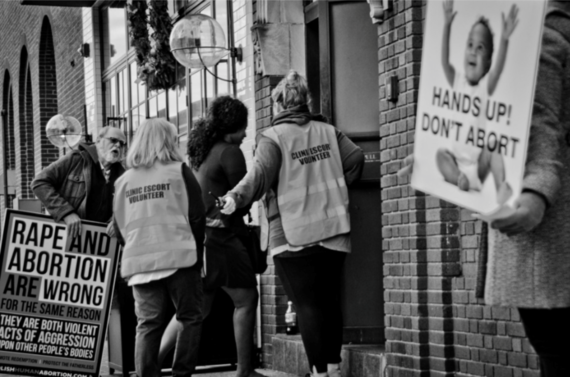
Protestors harass a patient outside of a women's healthcare clinic. Photo by and courtesy of Wendi Kent.
Whenever a woman is in public, there is always a chance she will face being shouted at, followed, or recorded without her permission. However, there is one place where that harassment is almost guaranteed. Women's health clinics have seen a rise in harassment and violence since the first murder of an abortion provider in 1993. This has risen especially within the past few years. The climate is so bad for these clinics that volunteer clinic escort teams have organized, simply to help patients walk from the sidewalk or parking lot to the front door. As a clinic escort myself, I have seen the extent of this problem first-hand.
Each clinic's atmosphere is different, as each state has different political leanings, religious influences, and laws surrounding women's healthcare. In general though, the themes are the same. Patients must walk through numerous, large posters depicting gory, aborted fetuses. They have their personal space violated by anti-choice protestors who follow them and try to convince them not to go inside the clinic.
When they finally get to the door, there are protestors preaching loudly, sometimes through megaphones, chastising these women for going inside. It gets so bad that even some of the more peaceful pro-life demonstrators criticize the protestors who scream at and follow patients. To make matters worse, the sound of the megaphones permeates the clinic walls, so that patients inside have to listen to these protests for the entirety of their appointment. Oftentimes, the loudest of the protestors are men, who think they know what women should do with their bodies and health better than the women trying to receive care.
Regardless of one's stance on abortion, most people should agree that women deserve the right to feel safe on their way to the doctor.
In addition to clinic escort teams, many clinics have been awarded legal buffer zones. Protestors cannot step foot in these areas, so that patients can feel safer in walking to the clinic. Although political buffer zones have been easily enacted in other scenarios, such as political polls, it is difficult to obtain a buffer zone for women's healthcare clinics. Even when they are obtained, they may not be enforced, depending on the religious or political beliefs of the on-duty police officers. Anti-choice groups often try to repeal these buffer zones by citing freedom of speech.
Although freedom of speech does not protect harassment and intimidation, these cases often swing in the favor of the anti-choice movement. Just recently, anti-choice protestors were even given permission to violate the city noise ordinance in Portland, Maine.
Clinics in Madison, Wisconsin have obtained a "floating buffer zone," in which people within 160 feet of the facility have an eight-foot boundary that protestors cannot cross. Other buffer zones have spanned as wide as 35 feet. These boundaries allow protestors to practice their freedom of speech without causing any physical or emotional harm to patients trying to access the clinic. However, in most other places, the buffer zone can be as little as just eight square feet in front of the clinic entrance. This gives protestors more freedom to the sidewalk than the patients, who may not even be going to the clinic for an abortion. In many places like Richmond, Virginia, or Louisville, Kentucky, there is still no buffer zone at all.
These protests go beyond freedom of speech. The last time I escorted for a clinic, three different women were crying by the time they got inside. This is not an uncommon occurrence. These women and their companions are slut-shamed, insulted, and even threatened. Protestors sometimes violate the buffer zone, but these infractions are hard to prove.
Oftentimes, since our focus is on the safety of the patients and not necessarily on the bad behavior of the protestors, we can only pull our cameras out to record after a threat has been made or the buffer zone has been invaded. For the safety and security of the patients, we also never take any photos or videos that could be used to identify them. On the other hand, this is something that anti-choice protestors are not afraid to do.
This issue is not pro-life verses pro-choice. Regardless of one's stance on abortion, most people should agree that women deserve the right to feel safe on their way to the doctor. The clinic that I volunteer at received their buffer zone through clinic escorting, documenting harassment from protestors, lobbying, emailing weekly reports to the city council (as well as the city and clinic attorneys and the chief of police), and partnering with the local National Organization of Women chapter to draft buffer zone legislation.
Buffer zones create harassment-free environments for patients. I urge you to fight for a buffer zone in your area. It can mean the difference between women being scared away from their doctor's appointments, and women feeling safe enough to receive the care that they need.
